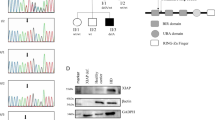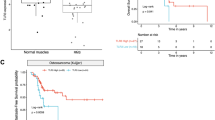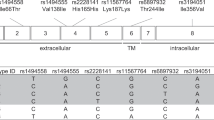Abstract
The immunosuppressive phenylalanine oxidase interleukin 4-induced gene 1 (IL4I1), primarily produced by antigen-presenting cells, inhibits T-cell proliferation and promotes the generation of Foxp3+ regulatory T cells in vitro. Highly expressed by tumour-associated macrophages from human cancers, IL4I1 has a potential role in immune evasion from the anti-tumour immune response. We have reviewed single-nucleotide polymorphisms (SNPs) and mutations described for the exon 4 of the IL4I1 isoform 1, which is expressed in lymphoid tissue. Two of them were expressed in an exogenous system to analyse their effect on the enzymatic activity. The N92D SNP leads to a hyperactive enzyme, while the R102G mutation is hypomorphic. Moreover, we show that IL4I1 activity is not only directed against phenylalanine, as initially described, but also at a lower level against arginine. These data pave the way to more extensive analyses of the mutational state of IL4I1 in pathological conditions such as cancer, where its participation in immune system dysfunctions may have therapeutic implications.
This is a preview of subscription content, access via your institution
Access options
Subscribe to this journal
Receive 6 digital issues and online access to articles
$119.00 per year
only $19.83 per issue
Buy this article
- Purchase on SpringerLink
- Instant access to full article PDF
Prices may be subject to local taxes which are calculated during checkout



Similar content being viewed by others
Accession codes
References
Carbonnelle-Puscian A, Copie-Bergman C, Baia M, Martin-Garcia N, Allory Y, Haioun C et al. The novel immunosuppressive enzyme IL4I1 is expressed by neoplastic cells of several B-cell lymphomas and by tumor-associated macrophages. Leukemia 2009; 23: 952–960.
Lasoudris F, Cousin C, Prevost-Blondel A, Martin-Garcia N, Abd-Alsamad I, Ortonne N et al. IL4I1: an inhibitor of the CD8(+) antitumor T-cell response in vivo. Eur J Immunol 2011; 41: 1629–1638.
Chu CC, Paul WE . Fig1, an interleukin 4-induced mouse B cell gene isolated by cDNA representational difference analysis. Proc Natl Acad Sci USA 1997; 94: 2507–2512.
de Oliveira Junior NG, e Silva Cardoso MH, Franco OL . Snake venoms: attractive antimicrobial proteinaceous compounds for therapeutic purposes. Cell Mol Life Sci 2013; 70: 4645–4658.
Boulland ML, Marquet J, Molinier-Frenkel V, Moller P, Guiter C, Lasoudris F et al. Human IL4I1 is a secreted L-phenylalanine oxidase expressed by mature dendritic cells that inhibits T-lymphocyte proliferation. Blood 2007; 110: 220–227.
Wiemann S, Kolb-Kokocinski A, Poustka A . Alternative pre-mRNA processing regulates cell-type specific expression of the IL4l1 and NUP62 genes. BMC Biol 2005; 3: 16.
Forbes SA, Beare D, Gunasekaran P, Leung K, Bindal N, Boutselakis H et al. COSMIC: exploring the world's knowledge of somatic mutations in human cancer. Nucleic Acids Res 2015; 43: D805–D811.
Chavan SS, Tian W, Hsueh K, Jawaheer D, Gregersen PK, Chu CC . Characterization of the human homolog of the IL-4 induced gene-1 (Fig1). Biochim Biophys Acta 2002; 1576: 70–80.
Pawelek PD, Cheah J, Coulombe R, Macheroux P, Ghisla S, Vrielink A . The structure of L-amino acid oxidase reveals the substrate trajectory into an enantiomerically conserved active site. EMBO J 2000; 19: 4204–4215.
Moustafa IM, Foster S, Lyubimov AY, Vrielink A . Crystal structure of LAAO from Calloselasma rhodostoma with an L-phenylalanine substrate: insights into structure and mechanism. J Mol Biol 2006; 364: 991–1002.
Mason JM, Naidu MD, Barcia M, Porti D, Chavan SS, Chu CC . IL-4-induced gene-1 is a leukocyte L-amino acid oxidase with an unusual acidic pH preference and lysosomal localization. J Immunol 2004; 173: 4561–4567.
Munder M . Arginase: an emerging key player in the mammalian immune system. Br J Pharmacol 2009; 158: 638–651.
Roy A, Kucukural A, Zhang Y . I-TASSER: a unified platform for automated protein structure and function prediction. Nat Protoc 2010; 5: 725–738.
Zhang Y . I-TASSER server for protein 3D structure prediction. BMC Bioinformatics 2008; 9: 40.
Acknowledgements
We are profoundly in debt to WM Hempel for critical reading of the manuscript. We would also like to thank the students A Aubatin, P Schaeffer, M Sadio, N Mennad and M Miqueu for technical help. This work was supported by INSERM recurrent funds to INSERM U955 équipe 9.
Author information
Authors and Affiliations
Corresponding authors
Ethics declarations
Competing interests
The authors declare no conflict of interest.
Additional information
Supplementary Information accompanies this paper on Genes and Immunity website
Supplementary information
Rights and permissions
About this article
Cite this article
Molinier-Frenkel, V., Mestivier, D. & Castellano, F. Alterations of the immunosuppressive IL4I1 enzyme activity induced by naturally occurring SNP/mutations. Genes Immun 17, 148–152 (2016). https://doi.org/10.1038/gene.2015.55
Received:
Revised:
Accepted:
Published:
Issue Date:
DOI: https://doi.org/10.1038/gene.2015.55
This article is cited by
-
Knockdown of IL4I1 Improved High Glucose-evoked Insulin Resistance in HepG2 Cells by Alleviating Inflammation and Lipotoxicity Through AHR Activation
Applied Biochemistry and Biotechnology (2023)
-
Cell death pathologies: targeting death pathways and the immune system for cancer therapy
Genes & Immunity (2019)



